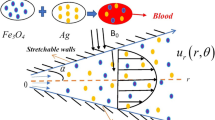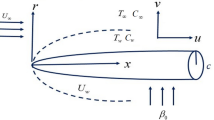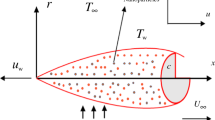Abstract
Fluid flowing over a thin needle has a significant contribution in the medical industry. Titanium oxide (TiO2) and gold (Au) nanoparticles have applications such as killing bacteria and cancer cells, and composition of these nanoparticles has potential industrial applications. Thus, the present work examines the flow attributes of Au–TiO2/ethylene glycol hybrid nanofluid flowing over a thin needle. The fluid flow is exposed to a uniform magnetic field, and fluid properties (dynamic viscosity and thermal conductivity) are considered to be temperature and nanoparticle’s shape dependent. In addition, the effect of quadratic convection with quadratic thermal radiation is investigated, and the process of heat transfer is explicated using Cattaneo–Christov heat flux model. The governing expressions are solved using Legendre wavelet collocation technique. The response of the involved parameters is displayed through tables and graphs. A comparison with published work is also presented, to validate the accuracy of the applied methodology. The obtained outcomes reveal that the temperature profiles of cylindrical-shaped nanoparticles are higher and blade-shaped particles are least. Moreover, the velocity of hybrid nanofluid increases with increasing the needle size. This happens because the inner part of the needle allows larger flow area, resulting in higher flow rates and velocities.





























Similar content being viewed by others
Abbreviations
- \({\text{Be}}\) :
-
Bejan number
- \({\text{Ec}}\) :
-
Eckert number
- \({\text{Gr}}\) :
-
Grashof number
- \({\text{Mn}}\) :
-
Magnetic parameter
- \(B_{0}\) :
-
Magnetic field strength (T)
- \(a\) :
-
Needle shape (cm)
- \({\text{Nu}}_{{\text{x}}}\) :
-
Nusselt number
- \({\text{Pr}}\) :
-
Prandtl number
- \({\text{Ra}}\) :
-
Radiation parameter
- \({\text{Re}}_{{\text{x}}}\) :
-
Reynolds number
- \(C_{{\text{f}}}\) :
-
Skin friction coefficient
- \(C_{{\text{P}}}\) :
-
Specific heat (J kg−1 K−1)
- \(T\) :
-
Temperature (K)
- \(\kappa\) :
-
Thermal conductivity (W m−1 K−1)
- \(\theta_{{\text{r}}}\) :
-
Temperature ratio
- \(e\) :
-
Velocity ratio
- \(u,\,v\) :
-
Velocity components along x- and y-axes, respectively (m s−1)
- \(T_{{\text{w}}}\) :
-
Wall temperature (K)
- \(\rho\) :
-
Density (kg m−3)
- \(\lambda_{{\text{i}}} ,\;1 \le i \le 7\) :
-
Dimensionless constant
- \(\mu\) :
-
Dynamic viscosity (kg m−1 s−1)
- \(\sigma\) :
-
Electrical conductivity (S m−1)
- \(\nu\) :
-
Kinematic viscosity (m2 s−1)
- \(\psi\) :
-
Legendre wavelet
- \(\theta\) :
-
Non-dimensional temperature
- \(\alpha\) :
-
Nonlinear convection parameter
- \(\kappa_{{\text{o}}}\) :
-
Reference thermal conductivity (W m−1 K−1)
- \(\mu_{{\text{o}}}\) :
-
Reference viscosity (kg m−1 s−1)
- \(\eta\) :
-
Similarity variable
- \(\sigma^{*}\) :
-
Stefan–Boltzmann constant (W m−2 K−4)
- \(\varepsilon\) :
-
Temperature-dependent viscosity parameter
- \(\beta\) :
-
Thermal expansion coefficient (K−1)
- \(\tau\) :
-
Thermal relaxation parameter
- \(\phi\) :
-
Volume fraction of nanoparticles (%)
- \(\infty\) :
-
Ambient conditions
- \({\text{Au}}\) :
-
Gold
- \({\text{hf}}\) :
-
Hybrid nanofluid
- \({\text{w}}\) :
-
Surface
- \(\prime\) :
-
Derivative w.r.t \(\eta\)
- DEs:
-
Differential equations
- EGN:
-
Entropy generation number
- EG:
-
Ethylene glycol
- ODEs:
-
Ordinary differential equations
- PDEs:
-
Partial differential equations
References
Ahmad R, Mustafa M, Hina S. Buongiorno’s model for fluid flow around a moving thin needle in a flowing nanofluid: a numerical study. Chin J Phys. 2017;55:1264–74.
Afridi MI, Qasim M. Entropy generation and heat transfer in boundary layer flow over a thin needle moving in a parallel stream in the presence of nonlinear Rosseland radiation. Int J Therm Sci. 2018;123:117–28.
Khan MWA, Khan MI, Hayat T, Alsaedi A. Entropy generation minimization (EGM) of nanofluid flow by a thin moving needle with nonlinear thermal radiation. Phys B Condens Matter. 2018;534:113–9.
Waini I, Ishak A, Pop I. Hybrid nanofluid flow and heat transfer past a vertical thin needle with prescribed surface heat flux. Int J Numer Methods Heat Fluid Flow. 2019;29:4875–94.
Upreti H, Kumar M. Influence of non-linear radiation, Joule heating and viscous dissipation on the boundary layer flow of MHD nanofluid flow over a thin moving needle. Multidiscip Model Mater Struct. 2020;16:208–24.
Sureshkumar RS, Ganesh KK, Rahimi GM, Khan I. Darcy-Forchheimer flow and heat transfer augmentation of a viscoelastic fluid over an incessant moving needle in the presence of viscous dissipation. Microsyst Technol. 2019;25:3399–405.
Hamid A. Terrific effects of Ohmic-viscous dissipation on Casson nanofluid flow over a vertical thin needle: buoyancy assisting & opposing flow. J Mater Res Technol. 2020;9:11220–30.
Huda NU, Hamid A, Khan M. Impact of Cattaneo–Christov model on Darcy–Forchheimer flow of ethylene glycol base fluid over a moving needle. J Mater Res Technol. 2020;9:4139–46.
Abbas N, Malik MY, Nadeem S, Alarifi IM. On extended version of Yamada-Ota and Xue models of hybrid nanofluid on moving needle. Eur Phys J Plus. 2020;135:1–16.
Khan U, Zaib A, Khan I, Nisar KS. Dual solutions of nanomaterial flow comprising titanium alloy (Ti6Al4V) suspended in Williamson fluid through a thin moving needle with nonlinear thermal radiation: stability scrutinization. Sci Rep. 2020;10:20933.
Reddy MG, Vijaya Kumari P, Upender Reddy G, Ganesh Kumar K, Prasannakumara BC. A mathematical framework on Cattaneo–Christov model over an incessant moving needle. Multidiscip Model Mater Struct. 2020;17:167–80.
Khan S, Ali F, Khan WA, Imtiaz A, Khan I, Abdeljawad T. Quasilinearization numerical technique for dual slip MHD Newtonian fluid flow with entropy generation in thermally dissipating flow above a thin needle. Sci Rep. 2021;11:15130.
Khan A, Kumam W, Khan I, Saeed A, Gul T, Kumam P, Ali I. Chemically reactive nanofluid flow past a thin moving needle with viscous dissipation, magnetic effects and hall current. PLoS ONE. 2021;16: e0249264.
Dinarvand S, Mousavi SM, Yousefi M, Nademi RM. MHD flow of MgO-Ag/water hybrid nanofluid past a moving slim needle considering dual solutions: an applicable model for hot-wire anemometer analysis. Int J Numer Methods Heat Fluid Flow. 2022;32:488–510.
Aladdin NA, Bachok N, Pop I. Boundary layer flow and heat transfer of Cu-Al2O3/water over a moving horizontal slender needle in presence of hydromagnetic and slip effects. Int Commun Heat Mass Transf. 2021;123: 105213.
Yasir M, Ahmed A, Khan M. Carbon nanotubes based fluid flow past a moving thin needle examine through dual solutions: stability analysis. J Energy Stor. 2022;48: 103913.
Sen SS, Das M, Nayak MK, Makinde OD. Natural convection and heat transfer of micropolar hybrid nanofluid over horizontal, inclined and vertical thin needle with power-law varying boundary heating conditions. Phys Scr. 2022;98: 015206.
Puneeth V, Manjunatha S, Makinde OD, Gireesha BJ. Bioconvection of a radiating hybrid nanofluid past a thin needle in the presence of heterogeneous–homogeneous chemical reaction. J Heat Transf. 2021;143: 042502.
Nayak MK, Mabood F, Makinde OD. Heat transfer and buoyancy-driven convective MHD flow of nanofluids impinging over a thin needle moving in a parallel stream influenced by Prandtl number. Heat Transf. 2020;49:655–72.
Mabood F, Muhammad T, Nayak MK, Waqas H, Makinde OD. EMHD flow of non-Newtonian nanofluids over thin needle with Robinson’s condition and Arrhenius pre-exponential factor law. Phys Scr. 2020;95: 115219.
Bianco V, Nardini S, Manca O. Enhancement of heat transfer and entropy generation analysis of nanofluids turbulent convection flow in square section tubes. Nanos Res Lett. 2011;6:1–2.
Mahapatra PS, De S, Ghosh K, Manna NK, Mukhopadhyay A. Heat transfer enhancement and entropy generation in a square enclosure in the presence of adiabatic and isothermal blocks. Numer Heat Transf A Appl. 2013;64:577–96.
Kefayati GR. Simulation of heat transfer and entropy generation of MHD natural convection of non-Newtonian nanofluid in an enclosure. Int J Heat Mass Transf. 2016;92:1066–89.
Akbar NS, Shoaib M, Tripathi D, Bhushan S, Bég OA. Analytical approach to entropy generation and heat transfer in CNT-nanofluid dynamics through a ciliated porous medium. J Hydrodyn. 2018;30:296–306.
Sheikholeslami M, Jafaryar M, Shafee A, Li Z. Nanofluid heat transfer and entropy generation through a heat exchanger considering a new turbulator and CuO nanoparticles. J Therm Anal Calorim. 2018;134:2295–303.
Singh K, Pandey AK, Kumar M. Entropy generation impact on flow of micropolar fluid via an inclined channel with non-uniform heat source and variable fluid properties. Int J Appl Comput Math. 2020;6:1–2.
Upreti H, Pandey AK, Kumar M. Assessment of entropy generation and heat transfer in three-dimensional hybrid nanofluids flow due to convective surface and base fluids. J Porous Media. 2021;24:35–50.
Upreti H, Pandey AK, Kumar M. Unsteady squeezing flow of magnetic hybrid nanofluids within parallel plates and entropy generation. Heat Transf. 2021;50:105–25.
Sreedevi P, Reddy PS. Entropy generation and heat transfer analysis of alumina and carbon nanotubes based hybrid nanofluid inside a cavity. Phys Scr. 2021;96: 085210.
Mathur P, Mishra SR, Purohit SD, Bohra M. Entropy generation in a micropolar fluid past an inclined channel with velocity slip and heat flux conditions: variation parameter method. Heat Transf. 2021;50:7425–39.
Mohanty B, Mohanty S, Mishra SR, Pattnaik PK. Analysis of entropy on the peristaltic transport of micropolar nanofluid: a simulation obtained using approximate analytical technique. Eur Phys J Plus. 2021;136:1–9.
Acharya S, Nayak B, Mishra SR. On the entropy analysis for the three-dimensional magnetohydrodynamic nanofluid over a shrinking surface. Numer Heat Trans A Appl. 2023;1–24.
Saleem N, Munawar S, Tripathi D. Entropy analysis in ciliary transport of radiated hybrid nanofluid in presence of electromagnetohydrodynamics and activation energy. Case Stud Therm Eng. 2021;28: 101665.
Munawar S, Saleem N, Tripathi D. Cilia and electroosmosis induced double diffusive transport of hybrid nanofluids through microchannel and entropy analysis. Nonlinear Eng. 2023;12:20220287.
Prakash J, Tripathi D, Akkurt N, Shedd T. Entropy analysis of hybrid nanofluid flow over a rotating porous disk: a multivariate analysis. Spec Top Rev Porous Media. 2023;14:45–9.
Bhandari DS, Tripathi D. Study of entropy generation and heat flow through a microtube induced by the membrane-based thermofluidics systems. Therm Sci Eng Prog. 2022;34: 101395.
Prasad KV, Vaidya H, Oudina FM, Ramadan KM, Khan MI, Choudhari R, Gulab RK, Tlili I, Guedri K, Galal AM. Peristaltic activity in blood flow of Casson nanoliquid with irreversibility aspects in vertical non-uniform channel. J Indian Chem Soc. 2022;99: 100617.
Marzougui S, Oudina FM, Magherbi M, Mchirgui A. Entropy generation and heat transport of Cu–water nanoliquid in porous lid-driven cavity through magnetic field. Int J Numer Methods Heat Fluid Flow. 2022;32:2047–69.
Preeti OO, Kambhatla PK, Oudina FM. Shape effect of MoS2 nanoparticles on entropy generation and heat transport in viscoelastic boundary layer flow. Pramana. 2021;95:182.
Marzougui S, Bouabid M, Oudina FM, Hamdeh NA, Magherbi M, Ramesh K. A computational analysis of heat transport irreversibility phenomenon in a magnetized porous channel. Int J Numer Methods Heat Fluid Flow. 2021;31:2197–222.
Samal SK, Moharana MK. Thermo-hydraulic and entropy generation analysis of recharging microchannel using water-based graphene–silver hybrid nanofluid. J Therml Anal Calorim. 2021;143:4131–48.
Najjaran S, Rashidi S, Valipour MS. An entropy production analysis for electroosmotic flow and convective heat transfer: a numerical investigation. J Therm Anal Calorim. 2021;145:1877–89.
Sreelakshmi K, Sandhya G, Sarojamma G, Vajravelu K, Chamkha AJ. Synthesis of entropy generation in Cu–Al2O3 water-based thin film nanofluid flow. J Therm Anal Calorim. 2022;147:13509–21.
Hayat T, Aziz A, Alsaedi A. Analysis of entropy production and activation energy in hydromagnetic rotating flow of nanoliquid with velocity slip and convective conditions. J Therm Anal Calorim. 2021;146:2561–76.
Tulu A, Ibrahim W. Mixed convection hybrid nanofluids flow of MWCNTs–Al2O3/engine oil over a spinning cone with variable viscosity and thermal conductivity. Heat Transf. 2021;50:3776–99.
Benkhedda M, Boufendi T, Tayebi T, Chamkha AJ. Convective heat transfer performance of hybrid nanofluid in a horizontal pipe considering nanoparticles shapes effect. J Therm Anal Calorim. 2020;140:411–25.
Hosseinzadeh K, Afsharpanah F, Zamani S, Gholinia M, Ganji DD. A numerical investigation on ethylene glycol-titanium dioxide nanofluid convective flow over a stretching sheet in presence of heat generation/absorption. Case Stud Therm Eng. 2018;12:228–36.
Alqahtani AM, Bilal M, Ali A, Alsenani TR, Eldin SM. Numerical solution of an electrically conducting spinning flow of hybrid nanofluid comprised of silver and gold nanoparticles across two parallel surfaces. Sci Rep. 2023;13:7180.
Razzaghi M, Yousefi S. The Legendre wavelets operational matrix of integration. Int J Syst Sci. 2001;32:495–502.
Ishak A, Nazar R, Pop I. Boundary layer flow over a continuously moving thin needle in a parallel free stream. Chin Phys Lett. 2007;24:2895.
Author information
Authors and Affiliations
Contributions
All the authors have equally contributed to complete the manuscript, i.e. HU formulated the problem and verified the problem statement, AKP completed the introduction section and checked the similarity with grammar, TG computed and simulated the numerical results, and finally, SU verified methodology and checked the overall.
Corresponding author
Additional information
Publisher's Note
Springer Nature remains neutral with regard to jurisdictional claims in published maps and institutional affiliations.
Rights and permissions
Springer Nature or its licensor (e.g. a society or other partner) holds exclusive rights to this article under a publishing agreement with the author(s) or other rightsholder(s); author self-archiving of the accepted manuscript version of this article is solely governed by the terms of such publishing agreement and applicable law.
About this article
Cite this article
Upreti, H., Pandey, A.K., Gupta, T. et al. Exploring the nanoparticle’s shape effect on boundary layer flow of hybrid nanofluid over a thin needle with quadratic Boussinesq approximation: Legendre wavelet approach. J Therm Anal Calorim 148, 12669–12686 (2023). https://doi.org/10.1007/s10973-023-12502-9
Received:
Accepted:
Published:
Issue Date:
DOI: https://doi.org/10.1007/s10973-023-12502-9




